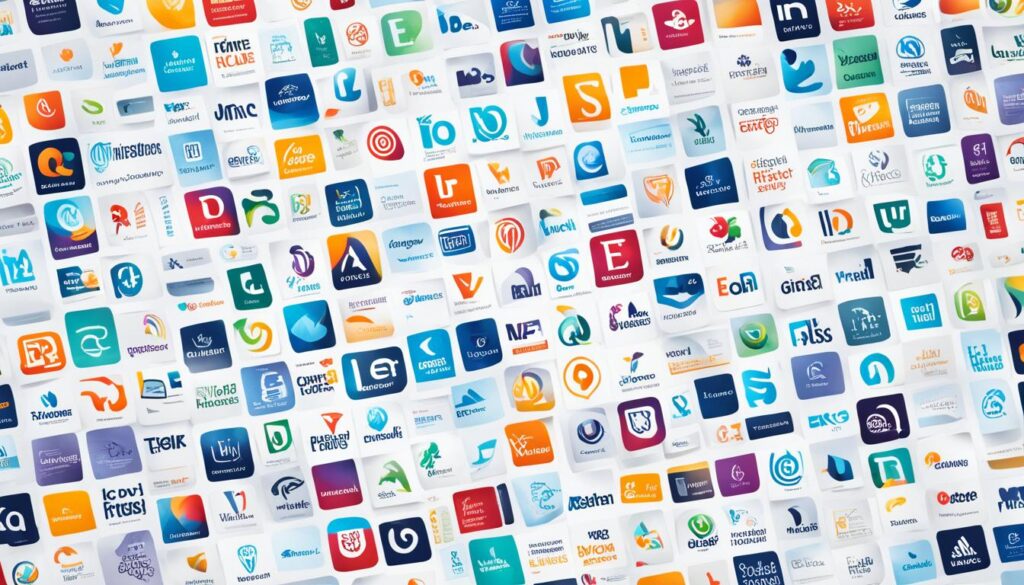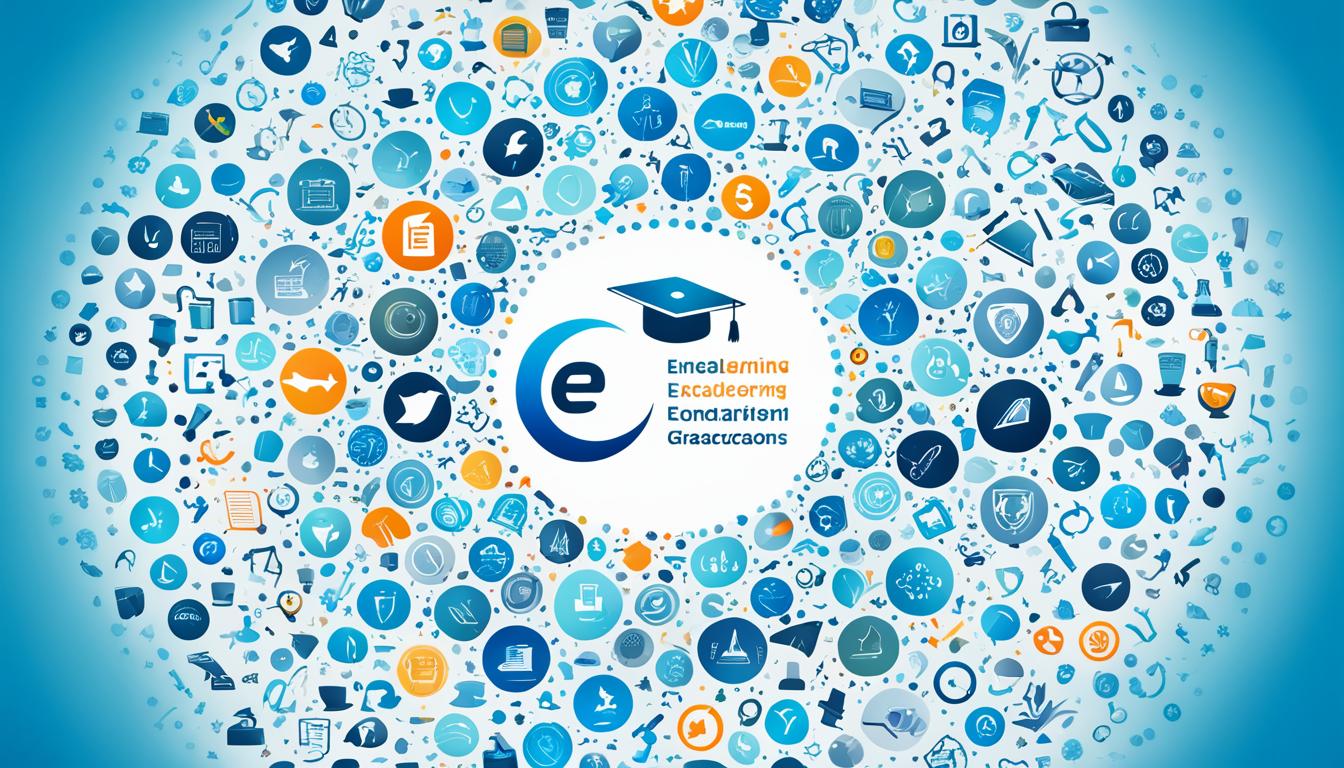Have you ever wondered how e-learning platforms are reshaping the future of higher education? In this era of rapid technological advancement, the shift towards online learning is no longer just a temporary trend; it is a significant transformation that is changing how education is delivered globally. For those keen on understanding the vast array of educational technology available, selecting the right e-learning platforms becomes a crucial decision that can enhance your academic experience, providing both flexibility and personalised learning opportunities.
The worldwide enthusiasm for e-learning platforms is evident from various market projections, highlighting significant growth in regions such as North America, where the online collaborative learning platform market is anticipated to reach impressive figures by 20311. Similarly, the Indian market is expected to flourish, showing a compound annual growth rate of 18.57% and a projected valuation of $28.46 billion by 20292. Such statistics signal profound changes in higher education, making it essential to stay informed about leading options available to students.
Key Takeaways
- E-learning platforms offer unprecedented flexibility and convenience for learners.
- Personalised learning experiences enhance student outcomes.
- Market growth for e-learning is projected to continue significantly worldwide.
- Technological innovation plays a crucial role in the evolution of educational technology.
- Choosing the right platform can significantly impact your educational journey.
Introduction
The introduction to e-learning platforms marks a significant transformation in higher education. These platforms have become essential as they offer flexible learning opportunities tailored to a diverse demographic of students. The growth of online education is evident, with recent statistics highlighting that the India e-learning market is expected to grow at a CAGR of 18.57% during 2023-2029, reaching a size of $28.46 billion by 2029 from $10.24 billion in 20232. Such advancements reflect the increasing demand for scalable education solutions driven by technological progress, enhanced internet access, and supportive government initiatives2.
Digital learning initiatives have made it possible for learners to engage with course materials at their own pace, promoting inclusivity and accessibility. Platforms like The Continents States University are utilising innovative strategies to provide a rich learning experience. The rise of gamification in India’s e-learning sector has further heightened student involvement and motivation2. Gamified approaches have showcased a 48% increase in engagement among corporate learners, indicating a notable trend towards the integration of interactive elements in educational content2.
The Rise of E-Learning in Higher Education
The landscape of higher education is rapidly transforming, largely due to the adoption of e-learning initiatives. Understanding the growth trends in e-learning is essential for recognising the profound shifts taking place in educational frameworks. Factors such as digital transformation and the increasing prominence of educational technology are significantly influencing these trends, enriching learning experiences for students.
Understanding the Growth Trends
The growth trends in e-learning indicate a promising trajectory, with notable statistics reflecting the evolving dynamics of the e-learning market. Reports show that 73% of companies state that collaborative learning is a critical, strategic requirement for success in the modern workplace3. This statistic reinforces the value of flexible online education as a means to enhance the learning process and improve knowledge retention.
Tied to these developments, online education statistics reveal that businesses fostering a culture of shared learning report a 45% increase in employee productivity3. Such trends underscore the importance of integrating technology in education, with collaborative learning initiatives driving significant return on investment (ROI) in training, often reaching up to 50%3.
Impact of Technology on Education
The impact of technology on education cannot be overstated. Digital platforms and tools enhance collaboration, allowing for greater accessibility in higher education. Innovative solutions in educational technology have made it easier for students from diverse backgrounds to participate in learning opportunities, exemplified by various universities adopting state-of-the-art technologies to support student engagement.
For instance, the integration of Learning Management Systems (LMS) enables organisations to foster learning environments that are both interactive and responsive, improving educational outcomes significantly. As such, technology remains a pivotal element in the shifting paradigm of higher education, marking a clear preference for platforms that accommodate contemporary learning demands.

Ultimately, embracing these digital transformation strategies is crucial for institutions aiming to advance their educational offerings3.
Benefits of E-Learning Platforms
E-learning platforms offer numerous benefits that enhance the learning experience for students. With a focus on convenience in online learning, these platforms cater to diverse needs and preferences, making education more accessible than ever. Flexibility and convenience remain key attributes, allowing you to engage with coursework at your own pace while balancing other commitments. This progressive approach promotes student autonomy, enabling learners to manage their educational journeys effectively.
Flexibility and Convenience
The rise of flexible education through e-learning platforms allows you to structure your study time around your personal schedule. Students can explore a wide array of subjects, from established educational practices to innovative methodologies. Traditional rigid schedules are replaced by opportunities to learn when it is most convenient for you, ensuring the inclusion of working professionals and those with familial responsibilities. This convenience fosters a learner-centric approach that optimises the overall learning experience.
Personalised Learning Experiences
Personalised e-learning illustrates the effectiveness of customised education in meeting individual needs. Numerous platforms utilise advanced analytics to track your progress, identifying strengths and areas requiring additional focus. This data-driven insight allows for tailored resources and learning paths that cater specifically to your learning style, significantly improving engagement and retention rates. By leveraging personalised e-learning, students can enjoy a more dynamic and responsive educational environment, supported by a culture of collaboration and growth.
Top E-Learning Platforms for Higher Education
In today’s rapidly evolving educational landscape, several platforms have emerged as leaders in providing online learning solutions. Understanding the best e-learning platforms for higher education is essential for students and institutions alike. This section explores platforms such as EdApp, Google Classroom, and Microsoft Teams, highlighting their unique e-learning platform features and technological offerings tailored to meet the demands of modern education.
Overview of Leading Options
EdApp stands out due to its user-friendly interface and mobile accessibility, making it one of the best online course providers for students on the go. Google Classroom leverages Google’s extensive suite of productivity tools, facilitating seamless collaboration and communication between students and instructors. Microsoft Teams combines educational resources with its well-known communication tools, promoting an integrated learning experience.
Comparative Features of Each Platform
In a comprehensive platform comparison, users will find key differences and similarities among these leading platforms. Common features to consider include:
- Collaboration Tools: EdApp allows interactive learning through gamification, while Google Classroom integrates well with Google Drive for easy document sharing.
- Content Delivery: Microsoft Teams supports diverse content formats, from live lectures to recorded sessions, catering to various learning preferences.
- User Interfaces: EdApp’s simple design enhances user experience, whereas Google Classroom’s familiar environment appeals to many students.
A comparative analysis of these platforms illustrates how their unique strengths align with different educational needs. Understanding these e-learning platform features enables users to select the best solutions for their specific requirements, ensuring an engaging and effective educational journey.

Innovative Features of E-Learning Platforms
In today’s digital learning environment, the integration of innovative features into e-learning platforms significantly enhances the educational experience. Effective collaboration in e-learning not only facilitates communication among users but fosters a community of shared knowledge and resources.
Collaboration Tools and Resources
Many e-learning platforms offer interactive tools that encourage collaboration among students and educators. These resources encompass a variety of formats such as:
- Discussion forums for sharing ideas and insights
- Project management tools that streamline group assignments
- Real-time feedback systems to enhance understanding and learning outcomes
Collaboration in e-learning has been shown to drive a higher Return On Investment (ROI) in training by optimising knowledge transfer and application3. Additionally, it improves knowledge retention, ensuring critical information isn’t lost when participants leave3. This approach nurtures a sense of responsibility among peers, leading to increased job satisfaction and involvement3.
Advanced Analytics and Reporting
Advanced analytics on e-learning platforms equips educators with valuable data insights. Through educational reporting features, you can monitor student engagement and performance effectively. These capabilities include:
- Learning analytics to track progress
- Defining precise performance measurements
- Identifying areas that need improvement in teaching methodologies
The effective use of learning analytics aids in cultivating a culture of open communication, contributing to business agility in adapting to market changes3. This data-driven approach allows organisations to invest wisely in their future workforce4.
Choosing the Right E-Learning Platform
When selecting e-learning platforms, thorough platform decision-making is crucial to match your educational needs. Begin with a detailed needs assessment that considers user experience, functionality, and integration capabilities. Evaluate platforms based on the following criteria:
- User Interface: A clear and intuitive user interface enhances learner engagement, allowing users to navigate easily.
- Scalability: Ensure the platform can accommodate growth, particularly if your institution plans to expand course offerings or increase enrollment.
- Integration with Existing Systems: Compatibility with current systems, such as Learning Management Systems (LMS) or student information systems, simplifies data management and improves workflow.
Consider the specific educational goals and preferences of your learners when refining your choices. Gathering feedback from users during the needs assessment phase can provide insights into what features are most valued. Furthermore, understanding the latest trends in the online learning sector may influence your decision, as the growth of platforms like Coursera and edX exemplifies the shift towards accessible, quality education driven by technological advances5.
Integrating E-Learning into Traditional Education
Blended learning represents a powerful approach in the world of education, combining traditional face-to-face instruction with online components. This method allows for more flexible learning environments by integrating online and offline education. Institutions have adopted hybrid models to enhance student engagement and accommodate varying learning preferences. One notable example is The Continents States University, which has successfully implemented blended learning strategies, pushing the boundaries of educational innovation.
Blended Learning Approaches
The integration of blended learning involves several effective approaches, which can enhance the learning process. These can include:
- Flipped classrooms, where students engage with online materials before participating in hands-on activities.
- Asynchronous learning, allowing students to complete coursework at their own pace while receiving guidance from instructors.
- Synchronous sessions, combining real-time online interactions with traditional lessons.
Successful blended learning implementation relies on understanding e-learning best practices. Educators must ensure that online components align seamlessly with in-person interaction, thus maximising the educational experience.
Case Studies: Successful Integration
Real-world case studies highlight the effectiveness of blended learning in various educational settings. For instance, institutions that have embraced this model report improved student outcomes and satisfaction. Noteworthy examples include:
- The groundbreaking initiative at a Norwegian university that increased student engagement through a well-structured hybrid model.
- A UK institution that saw enhanced learning outcomes due to successful integration of e-learning platforms into traditional teaching.
- A successful case study from a prominent Australian university, demonstrating the viability of blended learning in diverse subject areas.
These successful case studies reinforce the relevance of blended learning as an essential educational strategy, fostering an environment that encourages lifelong learning and adaptability.
E-Learning Platforms: A Global Perspective
The landscape of e-learning platforms reveals considerable regional differences in adoption and the emphasis on international courses. Understanding these variations is crucial in grasping the global e-learning trends. Various factors contribute to regional e-learning disparities, including economic stability, technological access, and educational policies.
Regional Differences in Adoption
Market adoption rates of e-learning platforms differ widely across regions, largely due to infrastructure challenges and educational investment. For instance, North America is poised to see significant growth, with its online collaborative learning platform market projected to reach USD xx.x billion by 2031, driven by a robust economy and technological innovations1. Other regions face hurdles such as limited internet access and resources, impacting the effectiveness of e-learning implementations. This divergence reinforces the importance of tailoring approaches to suit local contexts while advancing global e-learning globalisation efforts.
Emphasis on International Course Offerings
As educational institutions strive to broaden their reach, international courses gain prominence in e-learning platforms. These offerings enable cross-border education, allowing students to engage with content from prestigious universities worldwide. Platforms such as Coursera and edX have pioneered this trend, utilising modern technologies like Artificial Intelligence to enhance personalisation in learning paths. The growth of MOOCs in the early 2000s marked a turning point, making higher education accessible to a broader audience5. E-learning technologies facilitate this exchange, enriching the learning experience and fostering global perspectives.

User Experience and Engagement in E-Learning
User experience in e-learning plays a crucial role in how effectively students engage with learning material. Interactive learning environments enhance student engagement by providing dynamic content that captivates attention and motivates learning. Platforms that prioritise intuitive design ensure that users can navigate seamlessly, reducing frustration and allowing focus on educational outcomes.
One effective method for enhancing student engagement includes the integration of gamification elements. By incorporating game-like features such as rewards and challenges, learners are more likely to remain motivated and retain information. Research indicates that students are significantly more involved when such interactive components are woven into the course structure6.
Furthermore, the utilisation of multimedia resources serves to enrich the learning experience. Videos, quizzes, and interactive modules cater to various learning styles, making education more accessible and enjoyable. These elements collectively contribute to creating an environment where learners feel valued and encouraged to participate actively.
In addition to this, effective community-building strategies can deepen engagement. Social media platforms and discussion forums foster a sense of belonging among students, connecting them with peers and instructors alike. This connection is fundamental in combating isolation often experienced in online learning, elevating the overall user experience in e-learning.
Challenges Faced by E-Learning Platforms
Numerous challenges confront e-learning platforms, primarily arising from technology limitations and the necessity for inclusive education. These e-learning challenges include various barriers that impede access and hinder the effective delivery of courses.
Technological Barriers
Technology limitations play a significant role in the challenges faced by e-learning platforms. Users often experience platform barriers related to internet connectivity and device compatibility. A substantial proportion of students may lack access to reliable internet services, restricting their ability to participate fully in online education.
Additionally, inadequate digital literacy among users can contribute to the ineffectiveness of e-learning solutions, ultimately leading to negative outcomes for learners. Educators and institutions must recognise these limitations and strive for solutions that enhance access, ensuring that technology empowers rather than hinders learning experiences.
Addressing Issues of Accessibility
Ensuring accessibility in e-learning is paramount for creating an inclusive educational environment. Institutions must implement measures to overcome barriers, such as adaptive technologies that cater to diverse learning needs and preferences. Accessible content is essential for enabling all learners to engage effectively with the educational material, thereby fostering a culture of inclusive education.
As educational institutions continue to develop their e-learning strategies, it is crucial to prioritise the removal of barriers and promote equitable access to learning. By committing to these goals, e-learning platforms can better serve a wider array of students and ensure that no individual is left behind in the digital education landscape.

The Future of E-Learning Platforms in Higher Education
The evolution of e-learning platforms in higher education is closely linked to various promising trends and innovations. Developments in emerging technologies, such as artificial intelligence and machine learning, are paving the way for more personalised and engaging learning experiences. As these technologies become integral, the future of e-learning appears increasingly dynamic, adapting to the needs of diverse learners.
Promising Trends and Innovations
Recent educational trends highlight the growing integration of technology in the learning process. For instance, the Certificate of Inclusive Teaching program at Elon University achieved full enrollment within just 24 hours, demonstrating the demand for quality professional development in diverse and inclusive education. This programme engaged a cohort of 27 faculty members, reflecting a significant commitment to educational policies that support diversity, equity, and inclusion7. The use of both virtual and in-person course options showcases how e-learning regulations can cater to varying preferences, ultimately enhancing the educational experience.
Additionally, the increasing popularity of alternative pathways, such as coding bootcamps and online technical certifications, resonates with Generation Z. This generation, being digital natives, is driving a shift away from traditional education, leading to a demand for e-learning that meets their unique career aspirations in fields like app development and data science8.
Impact of Policy Changes
Educational policies are crucial in shaping the future of e-learning platforms. Initiatives that promote access to digital resources directly affect the acceptance and growth of e-learning as a standard educational model. Recent author training sessions held by MDPI Romania emphasised the commitment to continuous professional development, showing how such educational policies can empower both students and educators9. As higher education reforms continue to evolve, the influence of supportive regulations will play a significant role in determining how effectively e-learning can adapt and thrive.
Impact of E-Learning on Student Outcomes
E-learning has demonstrated significant potential in enhancing student outcomes within higher education. Various studies provide insights into the e-learning effectiveness, evidencing improvements in both student performance and comprehension. Educational research reveals that students engaged in e-learning environments exhibit better retention rates compared to their traditional counterparts, further underscoring the importance of flexible educational experiences that these platforms provide10.
Studies Highlighting Effectiveness
Research indicates a strong correlation between e-learning and positive academic outcomes. For instance, findings show that students using e-learning platforms often achieve higher grades and deeper understanding of course materials. The adaptability of e-learning caters to individual learning styles, contributing to these enhanced performance metrics, matched with increased engagement levels. Such evidence underlines the role of e-learning in creating effective learning scenarios10.
Student Satisfaction and Retention Rates
High levels of student satisfaction are frequently linked to effective e-learning strategies. Reports illustrate how positive educational experiences on e-learning platforms correlate with increased retention in e-learning settings. These satisfied learners are less likely to withdraw from courses, reinforcing the argument that tailored e-learning approaches not only benefit student performance but also contribute significantly to retention rates11. This satisfaction-driven model fosters an encouraging environment for continued investment in e-learning innovations.
Conclusion
The exploration of e-learning platforms unveils a transformative approach to higher education, highlighting their capacity to enhance learning experiences and outcomes. As discussed, these platforms not only provide flexibility and accessibility but also foster personalised learning journeys, thereby reshaping the educational landscape for institutions like The Continents States University.
Considering the e-learning future, it is evident that technological innovations such as artificial intelligence and gamification are set to play pivotal roles in driving engagement and efficacy in learning environments. The educational technology summary reveals a rich history and an ever-evolving landscape that continues to adapt to the needs of students and educators alike, establishing a framework for a more collaborative and accessible form of education.
In closing, the final thoughts on e-learning suggest that as you navigate through various platforms, the emphasis should be on finding those that align with your educational goals and preferences. Embracing these tools can significantly enhance your educational experiences and prepare you for a knowledge-driven future, supported by robust online resources and innovative learning methodologies12513.
Source Links
- North America Online Collaborative Learning Platform Market Players – https://www.linkedin.com/pulse/north-america-online-collaborative-learning-duzcc
- The India E-learning Market to Reach $28.46 Billion by 2029, More than $18 Billion Opportunities in the Next 6 Years – Arizton – https://www.openpr.com/news/3609278/the-india-e-learning-market-to-reach-28-46-billion-by-2029-more
- Why Collaborative Learning Is The Secret To Your Company’s Growth – https://elearningindustry.com/why-collaborative-learning-is-the-secret-to-your-companys-growth
- North America Online Learning Market Forecast 2031 – https://www.linkedin.com/pulse/north-america-online-learning-market-forecast-sh7ec
- The Evolution of Online Learning Platforms – https://www.bulbapp.io/p/bc290a29-5b86-43a4-8ec1-37df06048690/the-evolution-of-online-learning-platforms
- Fantasy Leagues and Other Fan Engagement Strategies in College Football – https://www.eyeonannapolis.net/2024/08/fantasy-leagues-and-other-fan-engagement-strategies-in-college-football/
- Elon launches Certificate of Inclusive Teaching program – https://www.elon.edu/u/news/2024/08/02/elon-launches-certificate-of-inclusive-teaching-program/
- How to handle Gen Z’s silent rebellion against Parental Wisdom on Career Choices – https://www.standardmedia.co.ke/health/opinion/article/2001500171/how-to-handle-gen-zs-silent-rebellion-against-parental-wisdom-on-career-choices
- Poultry – https://www.mdpi.com/journal/poultry/announcements/9093
- Addressing Racism in Behavioral Sciences: Recent Insights in the Experimental Analysis of Fairness and Inequity Aversion – Behavior and Social Issues – https://link.springer.com/article/10.1007/s42822-024-00179-0
- Elite > 1 TB > 14-inch > Laptops – https://www.hp.com/id-en/shop/laptops-tablets/intel-laptops.html?cap=1-tb&scrnsizeus=14-inch&subbrand=elite
- How to Choose the Right Phone Plan – https://www.bulbapp.io/p/b2693f2b-35d1-478e-9447-76233a62751a/how-to-choose-the-right-phone-plan
- How Drones are Changing Various Industries – https://www.bulbapp.io/p/e38bcdb2-07cd-4bb6-a615-ad071bba53e5/how-drones-are-changing-various-industries


